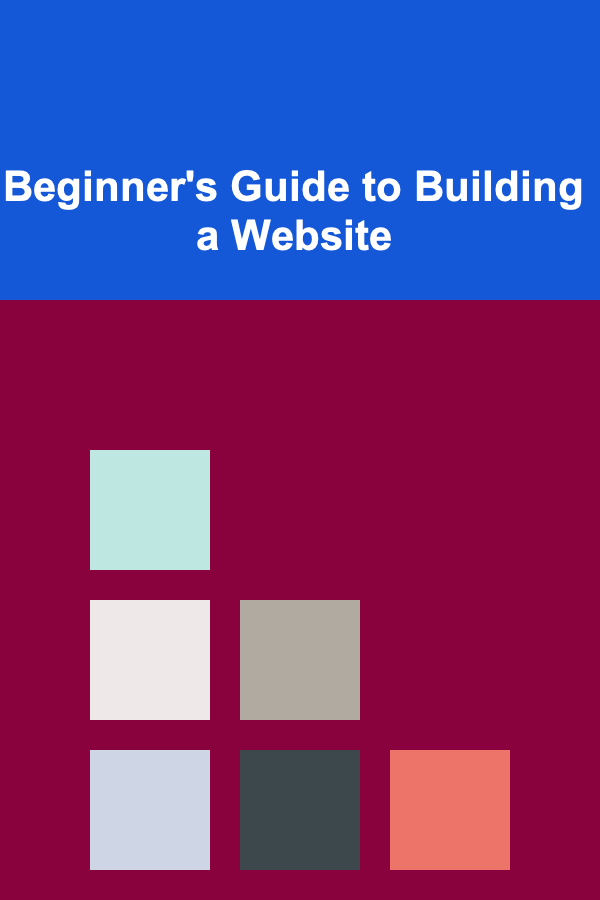
Beginner's Guide to Building a Website
ebook include PDF & Audio bundle (Micro Guide)
$12.99$11.99
Limited Time Offer! Order within the next:

Building a website may seem like a daunting task, especially if you're starting from scratch with no technical expertise. However, it is a manageable and achievable goal for anyone who wants to establish a digital presence. This guide will walk you through the essential steps to get your website up and running, from choosing a platform to launching your site and beyond.
Understanding the Purpose of Your Website
Before diving into the technical aspects of building a website, it's crucial to clarify the purpose of your site. Understanding why you're creating a website will help guide your decisions regarding design, functionality, and content.
- Personal or Portfolio Website: If you're a freelancer or creative professional, a portfolio website will showcase your work, such as writing, photography, design, or web development.
- Blog or Content Website: If you want to share your thoughts, stories, or expertise, a blog-style website will serve as your platform for content creation.
- Business or E-commerce Website: If you're running a business, your website could function as an online store, a service hub, or a lead-generation tool.
- Community or Non-Profit Website: If your goal is to connect with others or share a cause, building a community-focused or non-profit website will require specific features like forums, donation buttons, or event calendars.
Once you've identified the main purpose, you'll have a clearer idea of the features, design, and tools that are necessary for your website.
Choosing the Right Platform
Choosing the right platform is essential to the success of your website. There are several options, each with its advantages and challenges. The key is to pick a platform that aligns with your needs, technical skill level, and long-term goals.
2.1 Content Management System (CMS)
A Content Management System (CMS) is software that allows you to create and manage digital content with minimal technical knowledge. There are a few popular CMS options:
- WordPress : The most widely used CMS, WordPress powers more than 40% of all websites. It is highly customizable with themes and plugins, making it suitable for any type of website---from blogs to full-fledged e-commerce sites. WordPress can be hosted on your own server or through managed hosting services like WordPress.com.
- Wix: A beginner-friendly website builder that allows users to design websites using a drag-and-drop interface. It's ideal for personal websites, small businesses, and portfolios.
- Squarespace: Known for its beautiful, professionally designed templates, Squarespace is an all-in-one website builder that offers integrated hosting. It's popular among creatives, small business owners, and e-commerce sites.
- Joomla: While not as popular as WordPress, Joomla offers a bit more complexity and customization. It can be a great choice for developers or those with technical expertise.
- Drupal: Best for those with advanced web development skills, Drupal is a powerful CMS used for complex and highly customized websites.
2.2 Website Builders
Website builders like Wix, Squarespace, and Weebly are the easiest way to get started building a website without needing any coding experience. They provide an intuitive interface with drag-and-drop functionality, so you can design your website visually.
Pros:
- Very user-friendly
- Quick setup
- Hosting is included
- Great for personal websites, blogs, or small businesses
Cons:
- Less flexibility for advanced customizations
- May become more expensive as you grow
- Limited scalability
2.3 Static Site Generators
For those with technical expertise or who prefer full control over the design and development process, static site generators like Jekyll , Hugo , and Gatsby can offer more flexibility. These platforms allow you to create static websites using code, making them ideal for developers.
Pros:
- High customization and performance
- Full control over your site's design and functionality
- No need for a database (which improves performance)
Cons:
- Requires coding knowledge
- More time-consuming
- Need to set up your own hosting
2.4 E-commerce Platforms
If you're building an online store, there are platforms that specialize in e-commerce:
- Shopify: A user-friendly platform designed specifically for e-commerce websites. Shopify takes care of hosting, security, and technical aspects so you can focus on your business.
- WooCommerce: A WordPress plugin that turns your WordPress site into a fully functional online store. Ideal for those who are already using WordPress.
Domain Name and Hosting
Once you've chosen a platform, you need a domain name and web hosting to make your website accessible on the internet.
3.1 Choosing a Domain Name
Your domain name is your website's address on the internet. It should be short, memorable, and reflect the purpose of your website. Here are a few tips for choosing a great domain name:
- Keep it short and simple: A domain name that's easy to type and remember is key.
- Use keywords: If possible, include relevant keywords in your domain name. For example, if you're starting a gardening blog, consider using words like "garden" or "plants."
- Avoid hyphens and numbers: These can make the domain harder to remember and can cause confusion.
- Pick the right extension: The most common extension is .com, but there are also other options like .net, .org, or niche-specific extensions like .shop or .blog.
You can purchase domain names from registrars like GoDaddy , Namecheap , or Google Domains.
3.2 Choosing a Web Host
Web hosting is where your website lives on the internet. It's crucial to choose a reliable hosting provider. Here are some types of hosting:
- Shared Hosting: The most affordable option, where your website shares server space with other sites. Good for small websites with limited traffic.
- VPS Hosting: Offers more power and flexibility, ideal for websites with moderate traffic or growth potential.
- Dedicated Hosting: You get an entire server for your website. Best for large websites or e-commerce sites.
- Managed WordPress Hosting: A hosting plan specifically optimized for WordPress sites, including automatic updates and backups.
Popular hosting providers include Bluehost , SiteGround , HostGator , and WP Engine.
Designing Your Website
The design of your website is one of the most important factors in attracting and retaining visitors. The overall design should be simple, functional, and aligned with your brand. Here's what you need to focus on:
4.1 Choosing a Template
Most platforms offer a selection of templates or themes that can serve as a starting point for your website design. These templates are pre-designed layouts that you can customize.
- WordPress: Offers a wide range of themes, both free and premium, which are customizable with plugins and custom CSS.
- Wix and Squarespace: These platforms provide professionally designed templates that you can easily customize using their visual editor.
4.2 Customizing Your Design
While templates are a great starting point, you'll likely need to customize them to suit your specific needs:
- Color Scheme: Choose a color palette that reflects your brand. Consistent colors throughout your website create a cohesive look.
- Typography: Select fonts that are easy to read. Stick to one or two font families to maintain consistency.
- Navigation: Your website should be easy to navigate. A clear menu with categories such as "About", "Services", "Blog", and "Contact" will make it easier for users to find what they need.
- Responsiveness: Ensure that your website is mobile-friendly. More than half of web traffic comes from mobile devices, so your site must look good on all screen sizes.
4.3 Essential Pages
Your website will likely need the following pages:
- Home Page: The first impression visitors will get of your website. It should clearly explain who you are and what you offer.
- About Page: A page that tells your visitors who you are and what your website or business is about.
- Contact Page: Include contact forms, your email address, or even a map if you have a physical location.
- Blog or Content: If you plan to regularly post content, create a blog page.
- Shop or Service Pages: If you're selling products or offering services, you'll need dedicated pages for each.
Publishing Your Website
Once your website design is complete, it's time to publish it. Here's how to go about it:
- Preview Your Website: Most website builders allow you to preview your site before it goes live. Use this feature to check how everything looks and functions.
- Check for Errors: Ensure all links work, images load properly, and there are no typos or broken content.
- Publish: Once everything is in order, hit the publish button! Your website is now live and accessible to the world.
Promoting Your Website
Once your site is live, you'll need to promote it to attract visitors:
- SEO (Search Engine Optimization): Optimize your content for search engines like Google to help your website rank higher in search results. Focus on keywords, meta descriptions, and alt text for images.
- Social Media: Promote your website on social media platforms like Facebook, Twitter, Instagram, and LinkedIn. Share content, connect with your audience, and drive traffic back to your site.
- Email Marketing: Collect email addresses through sign-up forms and send newsletters to your subscribers to keep them engaged and informed.
Maintaining Your Website
Building a website is not a one-time task. Regular maintenance is necessary to ensure your site stays up-to-date and secure:
- Update Content Regularly: Keep your content fresh by posting blogs, adding new products, or updating your portfolio.
- Security: Install security plugins, use strong passwords, and ensure your hosting provider offers SSL certificates to secure user data.
- Backups: Regularly back up your website to prevent data loss.
Conclusion
Building a website from scratch is an exciting journey that can be done with minimal technical expertise if you use the right tools and take the time to learn. Whether you're building a personal portfolio or an e-commerce business, following the steps outlined in this guide will ensure that you create a successful and functional website. With ongoing effort and attention to detail, your website can grow and evolve, helping you achieve your goals and reach a wider audience. Happy building!

Building Stronger Communities Together: Insights from a Successful Community Outreach Coordinator
Read More
Creating Long-Term Passive Income Using Deep Learning Tools
Read More
How to Combine Modern and Traditional Lighting Styles in Your Home
Read More
How to Earn Money by Selling Pre-Trained Deep Learning Models
Read More
How to Keep Your Bathroom Sparkling with Minimal Effort
Read More
How to Sort and Store Hair Care Products Effectively
Read MoreOther Products

Building Stronger Communities Together: Insights from a Successful Community Outreach Coordinator
Read More
Creating Long-Term Passive Income Using Deep Learning Tools
Read More
How to Combine Modern and Traditional Lighting Styles in Your Home
Read More
How to Earn Money by Selling Pre-Trained Deep Learning Models
Read More
How to Keep Your Bathroom Sparkling with Minimal Effort
Read More